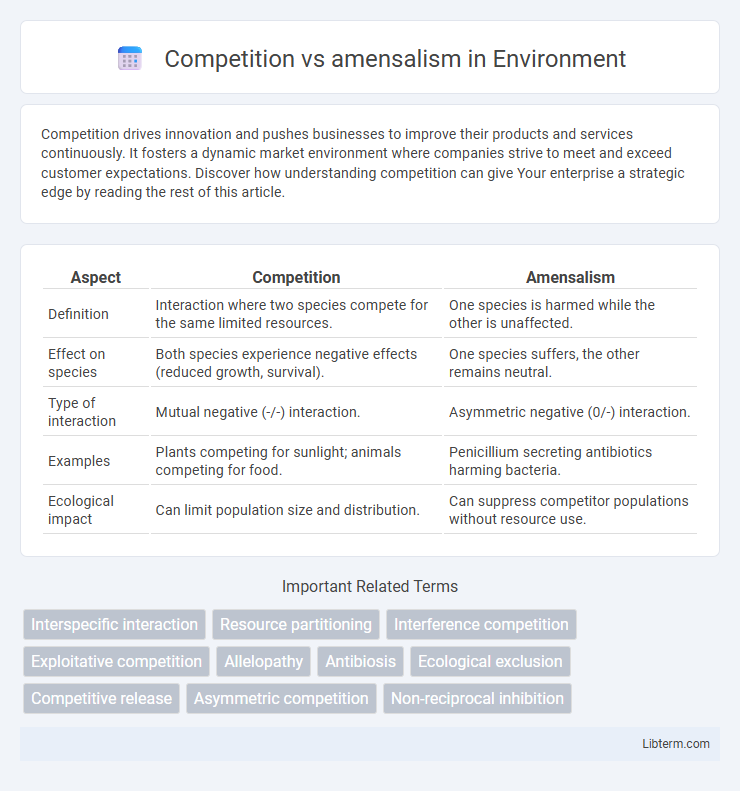Competition drives innovation and pushes businesses to improve their products and services continuously. It fosters a dynamic market environment where companies strive to meet and exceed customer expectations. Discover how understanding competition can give Your enterprise a strategic edge by reading the rest of this article.
Table of Comparison
| Aspect | Competition | Amensalism |
|---|---|---|
| Definition | Interaction where two species compete for the same limited resources. | One species is harmed while the other is unaffected. |
| Effect on species | Both species experience negative effects (reduced growth, survival). | One species suffers, the other remains neutral. |
| Type of interaction | Mutual negative (-/-) interaction. | Asymmetric negative (0/-) interaction. |
| Examples | Plants competing for sunlight; animals competing for food. | Penicillium secreting antibiotics harming bacteria. |
| Ecological impact | Can limit population size and distribution. | Can suppress competitor populations without resource use. |
Understanding Competition in Ecology
Competition in ecology occurs when two or more species vie for the same limited resources such as food, water, or shelter, leading to a negative impact on their population growth and survival. This interaction contrasts with amensalism, where one species is inhibited or harmed while the other remains unaffected, highlighting the asymmetrical nature of ecological relationships. Understanding competition involves analyzing niche overlap, resource partitioning, and the competitive exclusion principle to explain species coexistence and community structure.
Defining Amensalism in Biological Interactions
Amensalism is a biological interaction where one organism is inhibited or destroyed while the other remains unaffected, contrasting with competition where both species vie for the same resources, negatively impacting each other. In amensalism, the unaffected organism does not benefit nor suffer harm, such as in the case of black walnut trees releasing juglone, which inhibits nearby plant growth without gaining an advantage. This interaction highlights asymmetrical impacts within ecosystems, emphasizing the complexity of species relationships beyond mutual competition.
Key Differences Between Competition and Amensalism
Competition involves a negative interaction where two species vie for the same limited resources, reducing each other's growth or survival chances. Amensalism describes a relationship where one species is harmed or inhibited while the other is unaffected, often through the release of biochemical substances. Key differences include that competition affects both parties negatively, while amensalism impacts only one species without benefit or harm to the other.
Ecological Impacts of Competitive Relationships
Competitive relationships in ecosystems reduce resource availability, leading to decreased population sizes and altered species distributions. This interspecific interaction drives natural selection by favoring traits that enhance resource acquisition, contributing to biodiversity shifts. Unlike amensalism, competition generates reciprocal effects that significantly influence community structure and ecosystem resilience.
Effects of Amensalism on Community Structure
Amensalism negatively impacts community structure by inhibiting the growth or survival of one species without benefiting the other, often leading to reduced biodiversity and altered species distributions. This interaction can suppress dominant species, creating opportunities for less competitive organisms to establish and persist. Unlike competition, amensalism shapes community dynamics through asymmetric effects, influencing ecosystem stability and niche differentiation.
Examples of Competition in Nature
Competition in nature involves organisms vying for the same resources such as food, space, or light, exemplified by lions and hyenas competing for prey in the African savanna. Plants like oak and pine trees compete for sunlight and soil nutrients in dense forests, influencing growth and survival. This contrasts with amensalism, where one species is inhibited or destroyed while the other remains unaffected, such as the black walnut tree releasing juglone chemicals that suppress nearby plants without benefiting itself.
Real-World Cases of Amensalism
Amensalism occurs when one species is inhibited or destroyed while the other remains unaffected, such as black walnut trees releasing juglone toxin that suppresses nearby plant growth. In contrast to competition, where both species vie for the same resources with mutual impact, amensalism reflects a unilateral negative effect. Real-world examples include penicillium mold secreting penicillin that kills bacteria and barnacles settling on whales' skin without harming the host but deterring other organisms nearby.
Evolutionary Implications of Competition vs Amensalism
Competition drives natural selection by favoring traits that enhance resource acquisition and survival, leading to adaptive evolution within species. Amensalism exerts less directional evolutionary pressure since it typically harms one species without providing a direct advantage to the other, resulting in limited reciprocal adaptation. Over time, competitive interactions prompt coevolution and niche differentiation, whereas amensalism often maintains species distributions through passive suppression without significant evolutionary change.
Significance of Competition and Amensalism in Ecosystem Dynamics
Competition regulates population sizes by limiting access to essential resources, thus maintaining species diversity and ecosystem stability. Amensalism impacts community structure by inhibiting or harming certain species without direct benefit to the perpetrator, influencing species distribution and interactions. Both processes drive natural selection and resource partitioning, shaping ecological balance and promoting adaptive strategies within ecosystems.
Managing Competition and Amensalism in Conservation Biology
Managing competition and amensalism in conservation biology involves identifying species interactions where competition reduces resource availability for others, while amensalism causes harm to one species without benefit to the other. Effective strategies include habitat restoration to increase resource partitioning and reduce competitive exclusion, alongside controlling dominant species that exert negative effects through amensalistic interactions. Monitoring population dynamics and promoting biodiversity help maintain ecological balance, ensuring the persistence of vulnerable species affected by these interspecific relationships.
Competition Infographic

 libterm.com
libterm.com